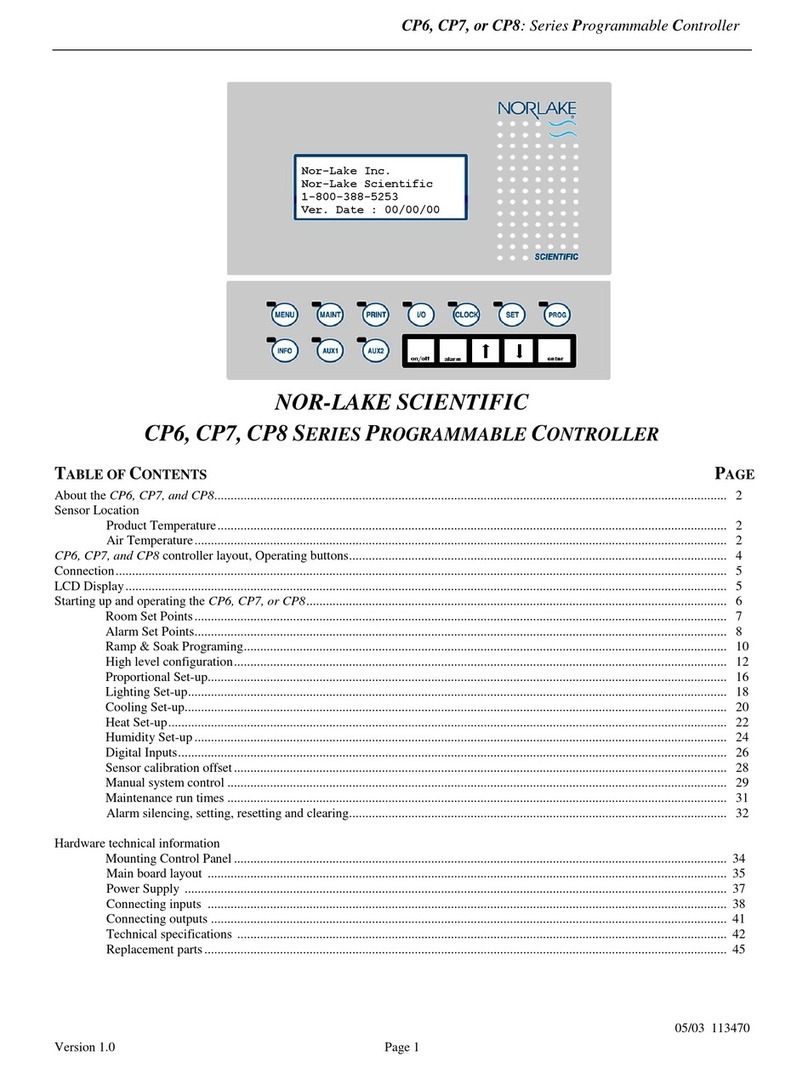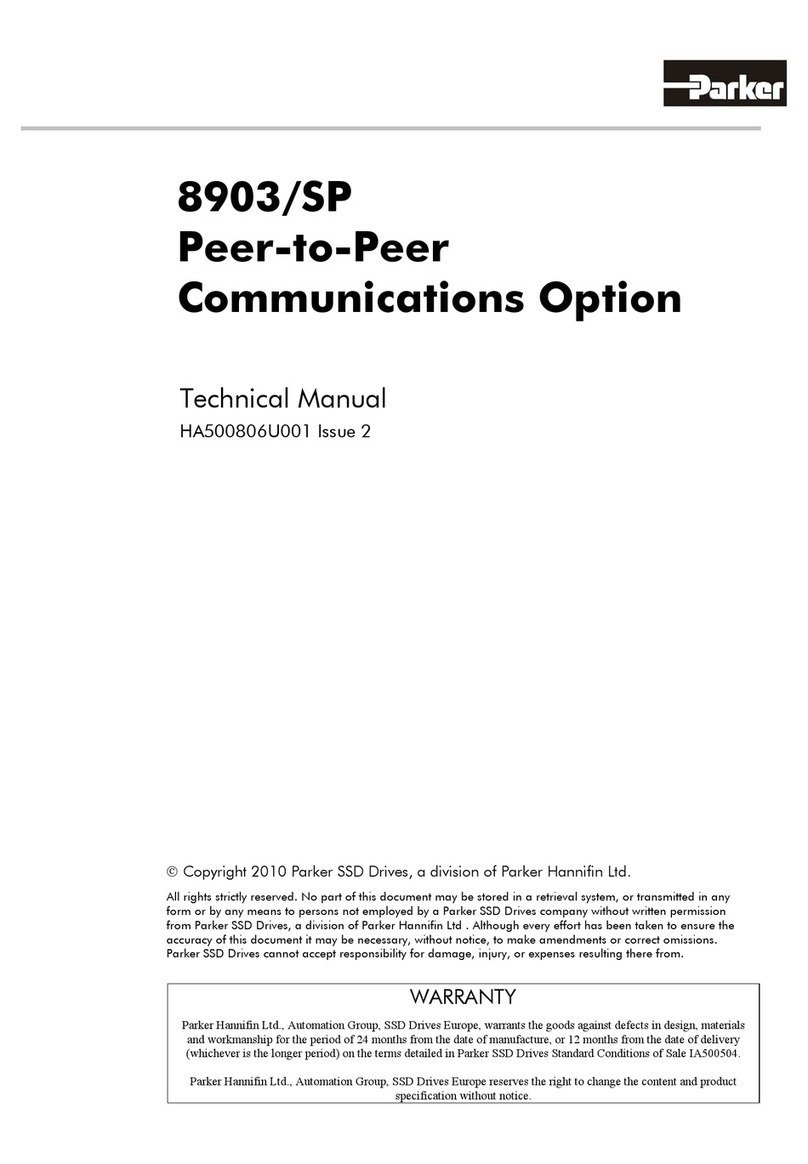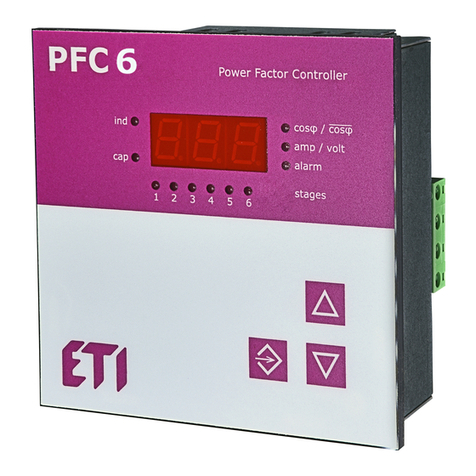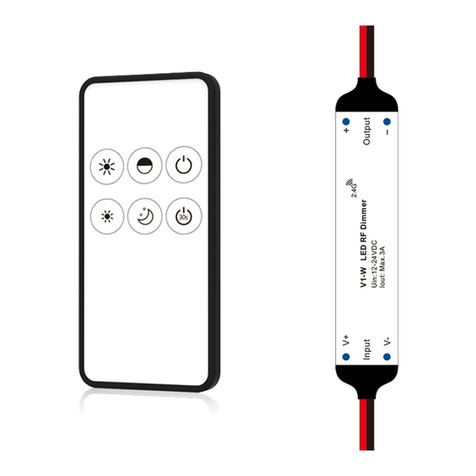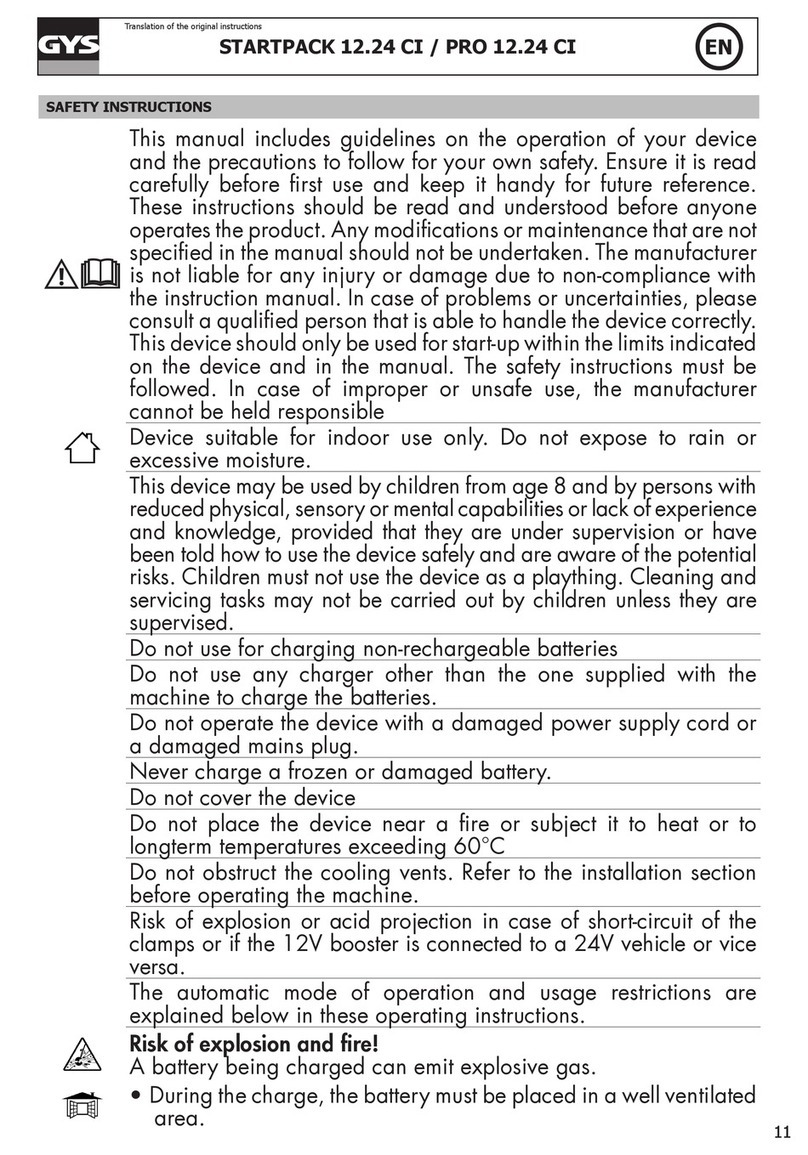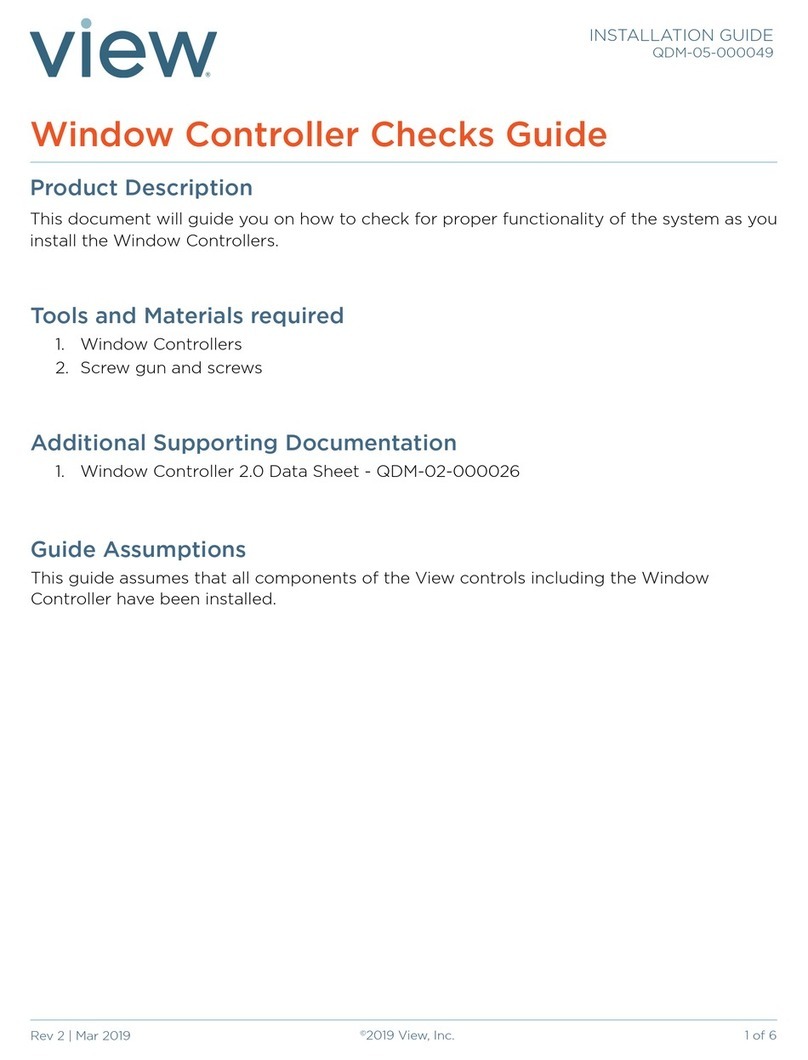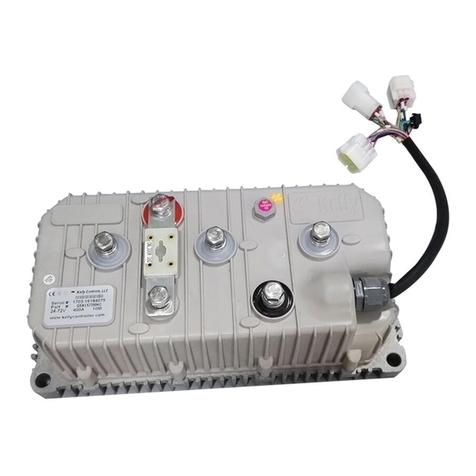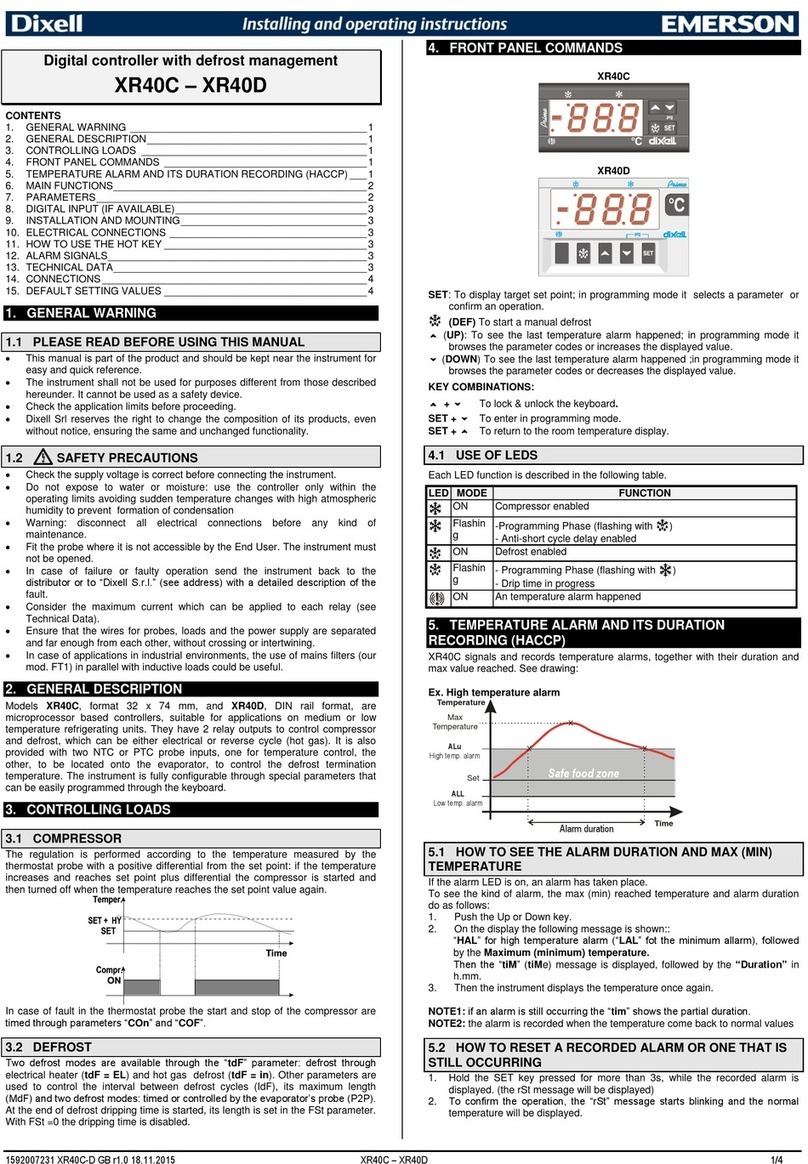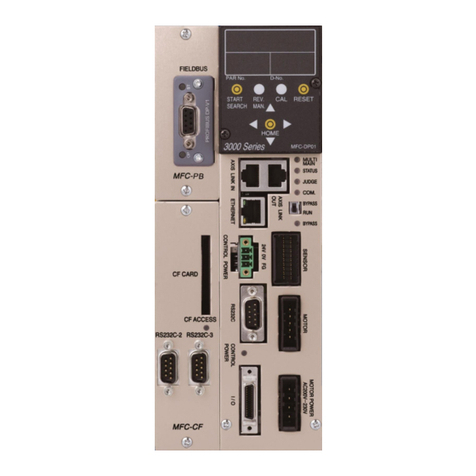Norlake LogiTemp Plus User manual

6/23, 171606 ©2023 Norlake, Inc. All rights reserved.
Operations Manual For
LogiTemp® Plus Reverse Cycle Defrost Electronic Controller System
Included In SciPak™ Self-Contained Refrigeration Systems

26/23, 171606 ©2023 Norlake, Inc. All rights reserved.
Important Notices
•Read this manual before operating your LogiTemp® Plus system. Keep
the manual and refer to it before doing any service on the
equipment. Failure to do so may result in personal injury or waived
warranty of damaged equipment.
•Modifications to existing equipment are subject to approval by
Refrigerated Solutions Group (RSG) and must be explicitly written.
There are no implied flexibilities designed for this product.
•Due to continuous product enhancements, RSG reserves the right to
make engineering changes and change specifications for product
improvement without notice.

36/23, 171606 ©2023 Norlake, Inc. All rights reserved.
Contents
INTRODUCTION ....................................................................................................................................................................... 4
WARNING LABELS AND SAFETY INSTRUCTIONS ...................................................................................................................... 5
APPLICATIONS.......................................................................................................................................................................... 6
LOGITEMP® PLUS DESCRIPTION .............................................................................................................................................. 7
FACTORY-MOUNTED PARTS .................................................................................................................................................... 8
LOGITEMP PLUS FEATURES...................................................................................................................................................... 9
SEQUENCES OF OPERATION .................................................................................................................................................... 9
Start-Up ............................................................................................................................................................................ 9
Off Mode .......................................................................................................................................................................... 9
Cool Mode ........................................................................................................................................................................ 9
Defrost Mode ................................................................................................................................................................. 11
Scheduled Defrost............................................................................................................................................ 11
Demand Defrost ............................................................................................................................................... 11
Manual Defrost ................................................................................................................................................ 12
Coil Drain Mode.............................................................................................................................................................. 12
Fan Delay Mode.............................................................................................................................................................. 12
Safety Mode ................................................................................................................................................................... 12
DEFINITION OF ONBOARD SYMBOLS..................................................................................................................................... 13
Status, Default And Reading Display .............................................................................................................................. 13
Alarm Display.................................................................................................................................................................. 15
SETTING PARAMETERS BY ONBOARD PUSHBUTTONS .......................................................................................................... 16
Users Level...................................................................................................................................................................... 16
Technicians Level............................................................................................................................................................ 16
Manual Valve.................................................................................................................................................................. 17
Clear Alarm ..................................................................................................................................................................... 17
Temperature Sensors ..................................................................................................................................................... 17
SENSOR SERVICE INSTRUCTIONS ........................................................................................................................................... 18
PRESSURE TRANSDUCER........................................................................................................................................................ 19
REVERSE CYCLE DEFROST....................................................................................................................................................... 21
General Information ....................................................................................................................................................... 21
Advantages ..................................................................................................................................................................... 21
Factory-Installed Parts.................................................................................................................................................... 22
Eliminated Parts.............................................................................................................................................................. 22
Defrost Time ................................................................................................................................................................... 22
ELECTRICAL AND WIRING ...................................................................................................................................................... 22
Typical Wiring Diagrams ................................................................................................................................................. 23
TYPICAL SET POINTS FOR CONTROLLER................................................................................................................................. 26
TROUBLESHOOTING GUIDE ................................................................................................................................................... 27

46/23, 171606 ©2023 Norlake, Inc. All rights reserved.
Introduction
Thank you for purchasing Norlake Scientific equipment. This manual contains important instructions for using the
LogiTemp® Plus electronic controller system. Please read it carefully.
DANGER
Improper or faulty hook-up of electrical components in the refrigeration units can result in severe injury or death.
All electrical wiring hook-ups must be done in accordance with all applicable local, regional or national standards.
NOTICE
Installation and service of the refrigeration and electrical components must be performed by a refrigeration mechanic
and/or a licensed electrician.
The portions of this manual covering refrigeration and electrical components contain technical instructions intended
only for persons qualified to perform refrigeration and electrical work.
This manual cannot cover every installation, use or service situation. If you need additional information, call or write:
Refrigerated Solutions Group
891 County Road U
Hudson, WI 54016
800-477-5253 - Norlake Scientific Sales
800-388-5253 - Norlake Scientific Parts/Service
rsgservice@refsg.com

56/23, 171606 ©2023 Norlake, Inc. All rights reserved.
Warning Labels And Safety Instructions
This is the safety alert symbol. When you see this symbol, be alert to the potential for personal injury or
damage to your equipment. Be sure you understand all safety messages and always follow recommended
precautions and safe operating practices.
NOTICE TO EMPLOYERS
You must make sure that everyone who installs, uses or services your refrigeration is thoroughly
familiar with all safety information and procedures.
Important safety information is presented in this section and throughout the manual. The following signal
words are used in the warnings and safety messages:
DANGER: Severe injury or death will occur if you ignore the message.
WARNING: Severe injury or death can occur if you ignore the message.
CAUTION: Minor injury or damage to your refrigeration system can occur if you ignore the message.
NOTICE: This is important installation, operation or service information. If you ignore the message, you
may damage your refrigeration system.
The warning and safety labels shown throughout this manual are placed on your Refrigeration
Solutions refrigeration system at the factory. Follow all warning label instructions. If any warning or
safety labels become lost or damaged, call our customer service department at 800-684-8988 for
replacements.
This label is on the housing of the refrigeration system typically located on the evaporator coil.

66/23, 171606 ©2023 Norlake, Inc. All rights reserved.
Applications
LogiTemp® Plus systems are designed to control SciPak™ refrigeration Systems for freezer and cooler applications.
Each system contains a condensing unit, evaporator(s) with LogiTemp Plus control board(s), electric expansion
valve(s), pressure transducers, temperature sensors, and reverse cycle valve.
Figure 1 below shows where the LogiTemp Plus controller is mounted on the system.
Figure 1: Location of the LogiTemp controller interface

76/23, 171606 ©2023 Norlake, Inc. All rights reserved.
LogiTemp® Plus Description
LogiTemp Plus is an OEM version of the custom-designed microprocessor-based electronic controller for RSG to control
an electric expansion valve in response to evaporator superheat and return air temperature. The hardware and
input/output descriptions and connections of a LogiTemp Plus are shown in figure 2 on page 8.
•RSV or SER Terminals. Ke2Therm RSV or Sporlan SER-type electric expansion valves are currently used for all
applications. RSV has 500 nominal steps for the entire valve stroke and SER; has 1596 nominal steps for the entire
valve stroke. The default is the RSV valve.
•Pressure Transducer XDCR is mounted at the evaporator suction header to measure saturated suction pressure in
absolute value but displayed in gauge pressure in PSIG as “PrS”. The suction pressure is converted to saturation
temperature displayed as “tSt”. The difference between suction outlet temperature and evaporating temperature
is the true superheat displayed as “SUP”.
•Suction Outlet/Fan Cut-In Temperature Sensor Tsuc is mounted on the suction line about 6” to 10” away from the
evaporator to measure outlet temperature during the cooling cycle and to serve as an evaporator fan cut-in
temperature sensor. The sensor is at a 2 or 10 o’clock position on the suction line. The default value of the fan cut-
in temperature is pre-set at 35°F for freezers and 55°F for coolers. It is displayed as “tSC”.
•Room Temperature Sensor TAir is typically mounted with a plastic tie at the drain pan on the side of the evaporator
return air. It is located around the middle of the evaporator to allow even airflow across it. If necessary it can be
relocated to a spot with better representation of the cold room temperature. It is displayed as “rtP”
•Defrost Termination Temperature Sensor TCoil is mounted downstream of the distributor tube after the valve and
close enough to the evaporator coil to measure defrost termination temperature during defrost cycle. Figure 2on
the next page shows the sensor locations of the evaporator and the controller. It is displayed as “tCL”.
•One 30 Amp NO NC 277 vac Relay is used for the compressor contractor or liquid line solenoid.
•One 30 Amp NO 277 vac relay is used to switch fans ON and OFF.
•One 30 Amp NO 277 vac Relay is used for a drain line heater.
•0-10VDC Output is used to drive an SSR relay for triggering a buzzer in the control panel indicating a local alarm
inside the LogiTemp Plus controller.
•One Ethernet Port is used for connecting the edge manager (router) in the control panel to the LogiTemp Plus
controller. This is used in unison with the iPad for an interface for the user to control the system.
•Display Connection is connected to a 3-Digit remote display and keypad.
•RS485 (a+, B-, Shield) Terminals are used to communicate with the remote display as well as auxiliary boards for
extended applications.
•Power Input 120 to 208/240 vac.
•Green, Yellow and Red LED Status Indicators. The green LED will be on when the compressor relay is energized.
The green LED will blink when the air temperature is satisfied, but the compressor minimum off timer has not yet
timed out. The red LED indicates a critical alarm has occurred (Low-Pressure Alarm). The yellow LED indicates all
other alarms.
•Four Push Buttons on the remote display are used to display set points and status as well as to reset operational
parameters like room temperature, defrost mode, number of defrosts, etc. Their functions can also be performed
by using the TCP/IP interface.

86/23, 171606 ©2023 Norlake, Inc. All rights reserved.
Factory-Mounted Parts
•A LogiTemp® Plus control board, an electric expansion valve, a pressure transducer, and three temperature sensors
are pre-mounted at the factory. For a reverse cycle defrost system, a four-way reversing valve is mounted in the
condensing unit. The defrost relay of a standalone or master evaporator controller is to provide power to the
solenoid coil of the four-way reversing valve.
•An Edge Manager (router) is installed in the accompanying control panel so that the customer can easily access the
home page and setpoints of the LogiTemp Plus controller.
Figure 2: Hardware and input/output descriptions and connections

96/23, 171606 ©2023 Norlake, Inc. All rights reserved.
LogiTemp® Plus Features
•The electric expansion valve replaces a thermal expansion valve. The refrigerant flow of the electric expansion valve is
modulated by the true superheat, or the difference between the evaporator outlet and evaporating temperatures.
•The room temperature sensor replaces the conventional temperature control. The temperature is set with the push
buttons on the LogiTemp Plus remote display or through its web page. The default temperature must be checked during
the first startup of the machine against the actual application temperature. The default must be reset to the actual
application temperature if there is a discrepancy.
•The onboard timer is used for runtime control and scheduling defrosts. No mechanical defrost timer is necessary for this
system. Once the power is turned on, the timer starts counting.
•The LogiTemp Plus controller has the capability to perform scheduled defrost or demand defrost
oWhen the scheduled defrost scheme is chosen, the onboard timer is used for scheduled defrosts. The system works in
the same fashion as a regular conventional system with a mechanical defrost timer
oWhen the demand defrost is chosen, the controller will not initiate a defrost unless it is needed. The low-temperature
system is pre-set with demand defrost.
•The demand defrost scheme is a pioneering design by RSG for freezer applications. Extensive lab tests indicate that many
unnecessary defrosts are eliminated and energy consumption reduced when using demand defrost compared to using a
conventional refrigeration system equipped with a mechanical defrost timer.
•The operational status of modes, room temperature and alarms are displayed on the three-digit remote display.
•The patented reverse cycle defrost control (United States Patent 7,073,344) reduces defrost energy usage by up to 80%
and decreases defrost time from 20-45 minutes (freezer equipped with electric heaters) to 3-5 minutes in a freezer or 1-
1/2 – 2 minutes in a cooler with a completely clean defrost.
Sequences Of Operation
Start-Up
•When power is applied to the board, the controller closes the valve.
•The controller will display “bLt” for 3 seconds then will show ‘StU’ on its three-digit remote display for 3 seconds.
•It will then display ‘CFn’ on the three-digit display for 9 seconds.
•The evaporator fans will be on for the first 9 seconds allowing a service technician time to check them.
•The controller will then turn the fans off and check each sensor.
•The controller will check the pressure transducer for a short or open. It will display ‘CPr’ on the three-digit display for
three seconds.
•If the sensor fails, the controller will display an alarm ‘PSA’ and go to safety mode for a failed sensor.
•If the sensor passes, it will display ‘oPr’ on the three-digit display for three seconds.
•The controller will check the sensor connected to ‘TSUC’ for a short or an open. It will display ‘Ct1’ on the three-digit
display for three seconds.
•If the sensor fails, the controller will display the alarm ‘SSA’ on the three-digit display and go to safety mode for a
failed suction sensor.
•If the sensor passes, it will display ‘ot1’ on the three-digit display for three seconds.
•The controller will check the sensor connected to ‘TAIR’ for a short or an open. It will display ‘Ct2’ on the three-digit
display for three seconds.
•If the sensor fails, the controller will display the alarm ‘ASA’ on the three-digit display and go to safety mode for a
failed air sensor.

10 6/23, 171606 ©2023 Norlake, Inc. All rights reserved.
•If the sensor passes, it will display ‘ot2’ on the three-digit display for three seconds. The controller will check the
sensor connected to ‘TCOIL’ for a short or an open. It will display ‘Ct3’ on the three-digit display for three seconds.
•If the sensor fails, it will display the alarm ‘CSA’ on the three-digit display and go to safety mode for a failed coil
temperature sensor.
•If the sensor passes, it will display ‘ot3’ on the three-digit display for three seconds.
•If all sensors pass, the controller will display ‘CFH’ on the three-digit display for six seconds.
•The controller will not go into defrost during the preceding start-up procedure. It will check the number of defrosts
per day (dPd) and timecoded (HOUR, MIN).
•If it is time for the controller to be in defrost, it will start in DEFROST mode. If not, the controller will start in COOL
(rEF) mode after fan delay.
•The set points are stored in EEPROM (Electrically Erasable Programmable Read Only Memory). Batteries are not
required to store the new set points. If power is lost, the set points which were in the controller at that time will be
used when power is restored.
Off Mode (Off)
•The controller starts in OFF mode by fully closing the valve.
•The controller will keep the valve closed for the minimum OFF Time (Cot) to keep the compressor in pump down or
off for a minimum amount of time.
•When room temperature reaches the cut-in set point (room temperature set point “tS” plus the temperature
difference set point “Atd”), the controller goes to COOL mode (rEF).
•If a scheduled defrost scheme is selected, while the controller is in OFF mode, it is constantly checking the number
of defrosts per day and the timecoded and calculating the time for defrost.
•When the timecoded is right for a defrost, it will immediately go into DEFROST mode (dEF) after the current OFF
mode.
•If the demand defrost scheme is selected, defrost will be checked and initiated only during the COOL mode.
•After the Minimum OFF Time is timed out and the room temperature reaches the Cut-In temperature, the controller
will go into COOL mode(rEF).
•While in OFF MODE, the three-digit display on Master will show ‘OFF’ for three seconds, ‘rtP’ for two seconds, and
the numerical display of the room temperature for four seconds.
Cool Mode (rEF)
•The controller starts COOL mode by opening the valve.
•The condensing unit will start with a suction line low-pressure control cut-in.
•The electric expansion valve is modulated by the controller so that a preprogrammed superheat set point is
maintained during the refrigeration process.
•Actual superheat is the temperature difference of the evaporator outlet (tSC,TSUC) and the evaporating temperature
(tSt,TSAT) converted from the reading of the pressure transducer, or TSUC-TSAT.
•The controller will keep modulating the valve so the superheat will equal the superheat set point.
•Meanwhile, the controller also reads the room air temperature rtP (TAIR).
•When the room temperature is below the room temperature set point (pre-set to -10 oF for low temp), it goes back
to OFF mode.
•All the time that the controller is in COOL mode rEF, it is constantly checking the criteria to determine if a defrost
should be initiated. It will immediately go into DEFROST mode (dEF) when defrost criteria are met.
•If the suction pressure is above the maximum operating pressure set point (HoP), the valve will modulate to control
the pressure at or below the maximum operating pressure set point (HoP).
•When the operating suction pressure is lower than HoP, it will go back to superheat control. Suction pressure is used
to calculate saturated

11 6/23, 171606 ©2023 Norlake, Inc. All rights reserved.
Defrost Mode (dEF)
There are two methods of initiating a defrost with the LogiTemp® Plus controller: scheduled defrost and demand
defrost. If the number of defrosts per day ‘dPd’ is set to 0, the controller will do the demand defrost by default. If the
number of defrosts per day ‘dPd’ is set from 1 to 8, the controller will do the scheduled defrost.
1. Scheduled Defrost
The following is the description of the scheduled defrost.
Note: The time of day can only be set through the web pages
•The time-of-day is an elapsed counter that counts the number of minutes that have passed. An elapsed
count of 0 is 12:00 AM.
•The count goes up to 1439 which corresponds to 11:59 PM.
•The counter then will reset to 0.
•The time of day will be kept if the input power is connected.
•If input power is turned off, then back on, time of day will be reset to 0 which corresponds to 12:00 AM.
•The first defrost start time is an elapsed time of 0 (12:00 AM).
•The subsequent defrost start times are determined by adding the number of minutes between each
defrost to the previous start time until there is a defrost start time for each defrost per day.
•The number of minutes between each defrost is determined by taking 1440 / number of defrosts per day
as set up by the ‘dPd’ set point.
•When starting an electric defrost, the FAN relay is de-energized to turn off the fans. The controller waits
for five seconds, then the DEFROST relay is energized to start a defrost.
•When starting a reverse cycle defrost, the FAN relay is de-energized to turn off the fans while, at the same
time, the COMPRESSOR relay is de-energized to turn off the compressor.
•There is a 10-second delay before the DEFROST relay is energized to switch the four-way reverse valve.
•Then there is a 30-second waiting period for pressure equalizing.
•Afterward, the COMPRESSOR relay is energized to turn the compressor.
•Hot gas will be reversed to flow to the evaporator while the electric expansion valve is modulated to start
a defrost.
•The controllers use the coil sensor ‘TCOIL’ as the defrost termination sensor.
•When this temperature gets above the preprogrammed Defrost Termination Set Point (dtP) before the
preprogrammed Maximum Defrost Time (dtL), the defrost will terminate. Otherwise, it will be terminated
when the Maximum Defrost Time (dtL) times out.
•While in DEFROST MODE, the three-digit display will be ‘dEF’ for three seconds, ‘dtt’ for two seconds, and
the numerical display of the temperature reading from sensor TCOIL for four seconds.
2. Demand Defrost
•When ‘dPd’ is set to ‘0’, the controller will initiate a demand defrost.
•The controller will not go to ‘DEFROST MODE’ until a heavy frost accumulation is in the evaporator coil.
•When frost is built up in the evaporator, it will block the air flowing through the evaporator coil and reduce
the heat transfer area.
•It will also decrease the evaporating temperature, which, in turn, increases the probability of frosting.
•A demand defrost scheme to detect the frost build-up and the criteria to start a defrost are programmed
in LogiTemp® Plus.
•Unlike scheduled defrost, LogiTemp Plus with demand defrost is really an energy saver. If no selection is
made, the controller will automatically select demand defrost when the power is applied to the controller.

12 6/23, 171606 ©2023 Norlake, Inc. All rights reserved.
•The defrost procedure is the same as described for the scheduled defrost.
•After selecting the demand defrost, if the elapsed time since the last defrost has been a selectable time
(Int) from 8 hours (480) to 72 hours (4320), Maximum Defrost Interval, LogiTemp Plus will go into defrost
to ensure a proper oil return.
Manual Defrost
The controller allows manually initiated defrost when needed. The manual defrost will be disabled if the evaporator
inlet sensor detects a temperature higher than the defrost termination temperature. The operation of the manual
defrost will be discussed in a later section.
Coil Drain Mode (Drn)
The controller automatically goes into COIL DRAIN whenever a defrost is terminated. The controller stays in this mode
for the preprogrammed ‘DRIP TIME’(drn). When this time is completed, the controller opens the expansion valve and
goes into FAN DELAY mode (FdL). While in COIL DRAIN MODE, the three-digit display on the controller will show ‘Drn’
for three seconds, ‘rtP’ for two seconds, and the numerical display of the room temperature for four seconds.
Fan Delay Mode (FdL)
The controller will pull down the temperature of the evaporator without the fans on until one of the following occurs:
The FAN DELAY TIME of five minutes times out or the fan cut-in sensor’s temperature (Fdt) TSUC goes below the FAN
DELAY TEMPERATURE of 20°F on freezers or 35°F on coolers. The controller will then go into COOL mode (rEF). While
in FAN DELAY MODE, the three-digit display will be ‘FdL’ for three seconds, ‘Fdt’ for two seconds, and the numerical
display of the temperature reading from sensor TSUC for four seconds.
Safety Mode
When an alarm occurs, such as a sensor failure or a communication alarm, the controller will go into ‘SAFETY MODE’.
SAFETY MODE provides minimum refrigeration to the refrigerated room before the corrective action is taken and the
alarm is cleared. The system will do the following in Safety Mode:
•Pressure Transducer Alarm (PSA)
oCool Mode (rEF)
Valve open for the minimum compressor run time (Crt)
Valve closed for the minimum compressor off time (Cot)
Keep doing the above cycle until the alarm goes away
Ignores maximum pressure control mode
•Outlet Sensor Alarm (SSA)
oCool Mode (rEF)
Valve open for the min compressor run time (Crt)
Close the valve for the minimum compressor off time (Cot)
Keep doing the above cycle until the alarm goes away.
oFan Delay Mode (Fdl)
oDefrost Mode (dEF)
•Room Temp Sensor Alarm (ASA)
oCool Mode (rEF)
Valve open for the min compressor run time (Crt)
Close the valve for the minimum compressor off time (Cot)
Keep doing the above cycle until the alarm goes away.

13 6/23, 171606 ©2023 Norlake, Inc. All rights reserved.
•Defrost Term Temp Sensor Alarm (CSA)
oDefrost Mode (dEF)
Use outlet sensor for defrost temperature termination
Open the valve until defrost terminates for reverse cycle defrost
Close the valve for electric defrost until defrost terminates
oIf this alarm and outlet temp sensor alarm, defrost will last only three minutes.
•Low Superheat Alarm (LSH)
oClose the valve and wait for alarm to go away
•High Room Temperature Alarm(HtA)
The high room temperature alarm occurs when the room temperature is above the preprogrammed ‘HIGH-
TEMPERATURE ALARM’ for a preprogrammed number of minutes. The alarm is cleared when the room
temperature is less than the ‘Room Temperature Setpoint + High temp Alarm Offset (Hao) set point’.
•Low Room Temperature (LtA)
The low room temperature alarm occurs when the room temperature is below the preprogrammed ‘LOW-
TEMPERATURE ALARM’ for a preprogrammed number of minutes. The alarm is cleared when the room
temperature is below the ‘Room Temperature Setpoint – Low Temp Alarm Offset (LAo) set point’.
•Communication Alarm (COA)
oFor Alternating Mode, (ALt) go to standalone mode.
oFor Synchronous Mode, (SYC)
oCool Mode (rEF)
oRun on superheat control for the minimum compressor run time
oClose the valve for the minimum compressor off time
oKeep doing above cycle until alarm goes away.
•Pumpdown Mode (Pdt)
oWait until pump downtime times out.
•Drip Mode (Drn)
oWait until Drip time times out.
•Defrost Mode (dEF)
oValve will close when defrost termination temperature meets its set point if reverse cycle defrost. The valve
will close at all time if the electric defrost. It will then wait until the full defrost time for other evaporators to
defrost.
oIf in demand defrost mode, defaults to three defrosts per day.
Definition Of Onboard Symbols
Status, Default And Reading Display
When the onboard green light is on, the compressor relay is energized. When the green light is blinking, the room
temperature sensor is satisfied, but waiting for the minimum off time or minimum run time to time out. When the
red light is on, there is a critical alarm. When the yellow light is on, there is a non-critical alarm.
The status and the digital data are displayed on the onboard three-digit LED display. Below is a list of the parameters
of the operational status.
Onboard 3-Digit Display Description
bLt LogiTemp® Plus
StU Indicates the status of Start Up Mode CFn Check fan working status
CPr Check pressure transducer
oPr Indicates the pressure transducer is working as it should

14 6/23, 171606 ©2023 Norlake, Inc. All rights reserved.
Onboard 3-Digit Display Description
Ct1 Check sensor TSUC, the suction temperature sensor
ot1 Indicates the TSUC is working as it should
Ct2 Check sensor TAIR, the room temperature sensor ot2 Indicates the TAIR is working
Ct3 Check sensor TCOIL, the coil temperature sensor
ot3 Indicates the TCOIL is working
CFH Indicates all sensors are OK
FdL Indicates FAN DELAY MODE
Fdt Actual TSUC value F in FAN DELAY
rEF Indicates REFR (COOL) MODE
rtP Room temp value in F
OFF Indicates OFF MODE
Pdt Indicates PUMPDOWN MODE before electric defrost dEF Indicates DEFROST MODE
Drn Indicates COIL DRAIN MODE
dtt Inlet sensor TCOIL value in DEFROST MODE
SoF System OFF mode
LAG Lag mode: Alternating or Lead Lag mode
A list of the parameters that can be displayed and/or changed is shown below when access to the default settings is
needed. Changes are usually made by a trained technician.
The following symbols are for viewing the status of the refrigeration system and cannot be changed.
Control Board
Output
rtP
Room or air temp connected to blue connector labeled ‘TAIR’(-60ºF to 150ºF)
SUP
Actual Superheat in rEF (COOL) MODE
PrS
Suction Pressure connected to gray connector labeled G B R for green, black, red leads
( -14 psig to 140 psig)
tSC
Suction Outlet Temperature Sensor connected to 2 pin black connector labeled ‘TSUC’
tSt
Saturated Suction Temperature calculated from Suction Pressure PrS
tCL
Coil/defrost Temperature connected to yellow connector labeled ‘TCOIL’
oPn
Percentage the EEV is open (0-99%)
StA
Statusofthecontroller:rEFforcoolmode,OFFforoff mode,dEFfordefrostmode,Drnfordrainmode,FdL for fan
delay mode, LAG for lag mode and SoF for system off mode
rCo
Compressor relay status: On if relay is energized, OFF if relay is de-energized
rdF
Defrost relay status: On if relay is energized, OFF if relay is de-energized
rFn
Fan relay status: On if relay is energized, OFF if relay is de-energized
AU1
Aux input 1’s status (see below for more details) connected to green connector labeled ‘AUX1’
AU2
Aux input 2’s status (see below for more details) connected to black connector labeled ‘AUX2’
AU3
Aux input 3’s status (see below for more details) connected to black connector labeled ‘AUX3’
iP1
first octet of ip address
iP2
second octet of ip address
iP3
third octet of ip address
iP4
fourth octet of ip address
Fir
firmware version

15 6/23, 171606 ©2023 Norlake, Inc. All rights reserved.
The following are manual modes of the controller and may be changed for diagnostic purposes:
These parameter values of the controller may be changed to customize the refrigeration system:
Alarm Display
Any alarm will cause the analog output voltage (across CN1) to switch. 10 VDC output corresponds to no alarms. 0
VDC corresponds to any alarm set. The 10VDC is wired to power an external alarm relay (SSR in the Cap Pak).
All alarms have a distinct display shown on the three-digit display on the controller. The red LED will be on for a
pressure or suction temperature sensor alarm and the amber LED will on for all other alarms. Multiple alarms can
exist. On the following page is the list of the alarm acronyms.
Remote 3-Digit Display Description
PSA pressure sensor alarm
SSA Suction Temp sensor alarm
ASA Air Temp sensor alarm
CSA coil sensor alarm
LSH low superheat alarm
HtA high air temperature alarm
LtA low air temperature alarm
LPA low suction pressure alarm
Control Board
Output
UCt
Manually change the control mode of the controller: Go from cool or off mode to defrost mode, from defrost
mode to
UOE
Manually open the EEV a percentage(0-99%)
CLA
Manually clear the alarms
bnd
When controller needs to communicate with other controllers, this mode will 'bond' the controllers to communicate
with each other
Control Board
Output
rFG
Refrigerant Type (If rFG = 449, then R-449A refrigerant, If rFG = 404, then R-404A refrigerant)
SSP
Superheat Set Point seen at the evaporator (5ºF to 20ºF)
tS
Room Temperature Set Point or "cut-out" (-40ºF to 75ºF range)
Atd
Cut-in Temperature Differential (0ºF to 25ºF)
COt
Minimum Time the EEV is closed, or minimum off time (0 to 15 minutes)
Crt
Minimum Time the EEV is open, or minimum run time (0 to 15 minutes)
LoP
Minimum Suction Pressure Set Point (-14.6 psi to 100.0 psig)
HoP
Maximum Suction Pressure Set Point (10.0 to 150 psig)
dPd
Number of Defrost/Day. When dPd=0, demand defrost, when dPd = 1 to 8, scheduled defrost
dtY
Defrost Mode (If dtY = ELE, then electric or air, If dtY = rCd, then reverse cycle
Int
Only applicable when in the demand defrost scheme and tS <=35ºF, this Set Point designates
the time between a safety defrost. Example; if Int = 480, then a defrost will occur every 8 hrs (480/60).
Pdt
Pump Down Timeout duration (0-90 minutes). Only applicable to elec. and air defrost schemes
dtP
Defrost Termination Temperature (35ºF to 90ºF)
dtL
Maximum Defrost Duration (0 to 90 minutes)
drn
Drip Time Duration (0 to 15 minutes)
bnt
Multiple Evaporator Mode, ALt = Alternating mode, SYC = Peer to Peer synchronous Mode
Ato
If in alternating mode, this value indicates the number of degrees above the cut-in Set Point
(tS + Atd + Ato) at which both controllers are overridden and both go into COOL MODE.
HAo
High Temperature Alarm Offset (0ºF to 99.0ºF)
LAd
Temperature Alarm Delay ( 0 to 120 minutes)
LAo
Low Temperature Alarm Offset ( 0ºF to 20ºF)

16 6/23, 171606 ©2023 Norlake, Inc. All rights reserved.
Remote 3-Digit Display Description
Dor Door open alarm
COA Comm alarm with other controllers
EA1 External Alarm 1
EA2 External Alarm 2
EA3 External Alarm 3
EFL Email failure alarm (email not sent)
A1A Aux Input 1 Temp sensor alarm
A2A Aux Input 2 Temp sensor alarm
A3A Aux Input 3 Temp sensor alarm
FrA flash memory read/write failure
CCA Comm alarm with comp sequencer
Setting Up Parameters By Onboard Push Buttons
There are two levels for programming the controllers with the three-digit display and four pushbuttons. The first
level (User’s Level) will enable the USER to set the room temperature set point ‘tS ’, the refrigerant set point ‘rFG’,
and the defrost type set point ‘dtY’; the second level (Technician’s Level) allows access to the other parameters as
described above.
User’s Level
•Press and hold the ‘ENTER’ button until the display reads ‘tS ‘ (about 3 seconds).
•Use the ‘up arrow’ and ‘down arrow’ buttons to scroll between room temperature set point ‘tS ’, refrigerant set point
‘rFG’, defrost type set point ‘dtY’, and password ‘PAS’ to enter the ‘TECHNICIAN LEVEL’.
•Press the ‘enter button’ to view the value of the selected set point.
•Use the up and down buttons to change the value.
•Press the ‘enter button’ to change the blinking digit.
•When the desired value is displayed, press and hold the ‘ENTER’ button until the name of the set point is displayed
(about 3 seconds).
•At any time, pressing the ‘BACK’ button will escape to the step before.
Technician’s Level
•Press and hold the ‘ENTER’ button until the display reads ‘tS ‘ (about 3 seconds).
•Use the ‘up arrow’ and ‘down arrow’ buttons to scroll to ‘PAS’.
•Press the ‘enter button’ and ‘000’ is displayed with the one’s digit blinking.
•Press the ‘up arrow button’ until the display reads ‘002’.
•Press and hold the ‘ENTER’ button (about 3 seconds) until a set point is displayed.
•Use the up and down buttons to get to the set point that is wanted. Press ‘enter button’ to view the value of the
selected set point.
•Use the up and down buttons to change the value.
•Press the ‘enter button’ to change the blinking digit.
•When the desired value is displayed, press and hold the ‘ENTER’ button until the name of the set point is displayed
(about 3 seconds).
•At any time, pressing the ‘BACK’ button will escape to the step before.

17 6/23, 171606 ©2023 Norlake, Inc. All rights reserved.
Manual Valve
•Press and hold the ‘down arrow button’ until the display reads a number. This is the valve open percentage.
•The tenths digit will be blinking.
•Press the ‘enter button’ to change the blinking digit
•Use the up and down buttons to increase or decrease the percentage open.
•At any time, pressing the ‘BACK’ button will escape manual valve mode and go back to auto mode.
•If no buttons are pressed for 1 hour, the controller will go back to auto mode.
Clear Alarm
•Press and hold the ‘ENTER’ button until the display reads ‘tS ‘ (about 3 seconds).
•Use the ‘up arrow’ and ‘down arrow’ buttons to scroll to ‘PAS’.
•Press the ‘enter button’ and ‘000’ is displayed with the one’s digit blinking.
•Press the ‘up arrow button’ until the display reads ‘002’.
•Press and hold the ‘ENTER’ button (about 3 seconds) until a set point is displayed.
•Use the ‘up arrow button’ or ‘down arrow button’ until display reads ‘CLA’.
•Press and hold the ‘enter button' until the red led flashes (about 3 secs)
Manual Defrost
•Press and hold the ‘enter button’ and the ‘down arrow button’ until the display flashes (about 3 seconds).
•If the controller was in ‘rEF’ or ‘OFF’, it will go to ‘DEF’. If the controller was in ‘DEF’, it will go to ‘drn’.
•If the controller was in ‘drn’, it will go to ‘Fnd’. If the controller was in ‘Fnd’, it will go to ‘rEF’.
Temperature Sensors
The application range of the temperature sensors used for this controller is -60 F to +150 F. If the sensor detects a
temperature out of the range, an alarm will show on the controller display.
Three temperature sensors are used in the LogiTemp® Plus refrigeration system:
•The room temperature return air sensor
•The evaporator defrost termination temperature surface sensor
•The evaporator outlet (suction line) temperature surface sensor.
All sensors are solid-state devices with the same characteristics that change electrical resistance in response to a
change in temperature.
The room temperature sensor is factory-mounted on the inner cowl wall in the evaporator inlet air. This placement
avoids heat from defrost heaters and lights and still allows a good air stream over the sensor.
The defrost termination sensor is mounted in the evaporator coil.
The outlet sensor is mounted on the suction line at the outlet of the evaporator. These can be seen in Figure 3 on the
next page. The second sensor shows the room air temperature sensor location.

18 6/23, 171606 ©2023 Norlake, Inc. All rights reserved.
Sensor Service Instructions
The temperature sensor cannot be repaired. Using the measurements in Char A on the next page, you can determine
if they are functioning correctly. If the sensors are found out of tolerance, they should be replaced.
As mentioned above, the temperature sensor changes electrical resistance in response to temperature changes.
Disconnect the sensor from the controller, check the temperature at the sensor location, then check and record the
resistance through the temperature sensor.
Procedures to check temperature sensor tolerance with ice water:
1) Use a cup of water with well-stirred ice. The water should be distilled and at an even 32 F.
2) Submerge the room temperature sensor (TAIR) into the water while the LogiTemp® Plus controller is normally
operating. Check the display for the value. If the sensor shows 32°F, it is working properly.
3) Press the up or down buttons until the display shows the name of one of the variables. When the display shows
tSC(TSUC), which is the suction temperature, press the “ENTER” button to show the digit value. Submerge the sensor
into the water. Check the display for the value. If the sensor shows 32°F, it is working properly.
4) Press the down button until the display shows tCL, which is the coil temperature TCOIL, press the “ENTER” button to
show the digit value. Submerge the sensor into the water. Check the display for the value. If the sensor shows 32°F,
it is working properly.
Compare the temperature and resistance in Chart A on the next page.
Figure 3: Sensor Locations

19 6/23, 171606 ©2023 Norlake, Inc. All rights reserved.
Chart A. Temperature/Resistance Characteristics (-50 to 80 F)
Temp. oF
Temp. oC
ohms*1k
Temp. oF
Temp. oC
ohms*1k
-50
-45.6
43.45
15
-9.4
7.579
-40
-40.0
32.31
20
-6.7
6.731
-35
-37.2
27.96
25
-3.9
5.993
-30 -34.4 24.27
30 -1.1 5.349
-25
-31.7
21.13
32
0
5.123
-20
-28.9
18.43
35
1.7
4.781
-15
-26.1
16.12
40
4.4
4.281
-10
-23.3
14.13
50
10.0
3.454
-5
-20.6
12.42
60
15.6
2.805
0
-17.8
10.94
70
21.1
2.294
5
-15.0
9.651
80
26.7
1.888
10
-12.2
8.544
NOTE: Use resistance at 32oF for sensor checking.
Pressure Transducer
The LogiTemp® Plus controller is equipped with one of two types of pressure transducer (PT). The difference is in the
color of the sensor wires as noted below:
Remove the transducers while the vacuum and charge take place.
New PT (19-14226, 19-14223) OLD PT (19-13955, 19-14092) Description
RED (R)
BLACK
+VDC (+5)
BLACK (B)
GREEN
GROUND (5-)
GREEN (G)
WHITE
SIGNAL (sig)
The GROUND is connected to terminal ‘5-‘on the board. The SIGNAL lead is connected to terminal ‘sig’ on the board. The
+VDC lead is connected to terminal ‘5+’ on the board. Chart B shows the characteristics of the pressure transducer.
NOTE: The pressure transducer cannot be repaired but replaced only.

20 6/23, 171606 ©2023 Norlake, Inc. All rights reserved.
Chart B. Pressure Sensor Simulation Values ( 0 to 150 PSIA)
Bar
PSIA
PSIG
V
(Signal to Ground)
0
0
-14.6
0.509
0.69
10
-4.6
0.784
1.379 20
5.4
1.058
2.069 30
15.4
1.332
2.758
40
25.4
1.587
3.448
50
35.4
1.862
4.137 60
45.4
2.136
4.827 70
55.4
2.391
5.516
80
65.4
2.665
6.206
90
75.4
2.920
6.895
100
85.4
3.194
7.585 110
95.4
3.469
8.274
120
105.4
3.724
Technical Notes
•An optional alarm relay (10VDC Coil) can be connected to terminals (+,-) of CN1. When the relay is energized, there’s
no alarm. The alarm does not indicate what causes the alarm. To find out what has caused the alarm, check the
onboard three-digit display for alarm codes and refer to the diagnosis chart for corrective action.
•Defrost termination set point (dtP) can also be set up to 80oF. When setting the defrost termination temperature,
make sure that the frost is free after each defrost. Also adjust the maximum defrost duration when necessary.
•Always clear the “LSH”, “HtA” and “LtA” alarms after corrective action is taken. The sensor and communication
alarms cannot be cleared unless they are corrected.
•Cat5/E communication cable should be rated 300 V 80oC or higher. If the wire is rated lower than 300 V, a separate
conduit must be used for communication cables.
Table of contents
Other Norlake Controllers manuals
Popular Controllers manuals by other brands
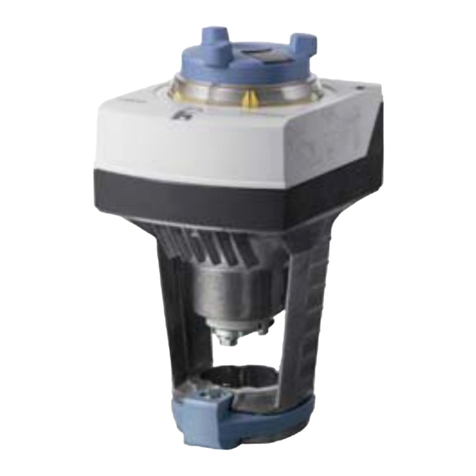
Siemens
Siemens Flowrite 599 Series Technical instructions
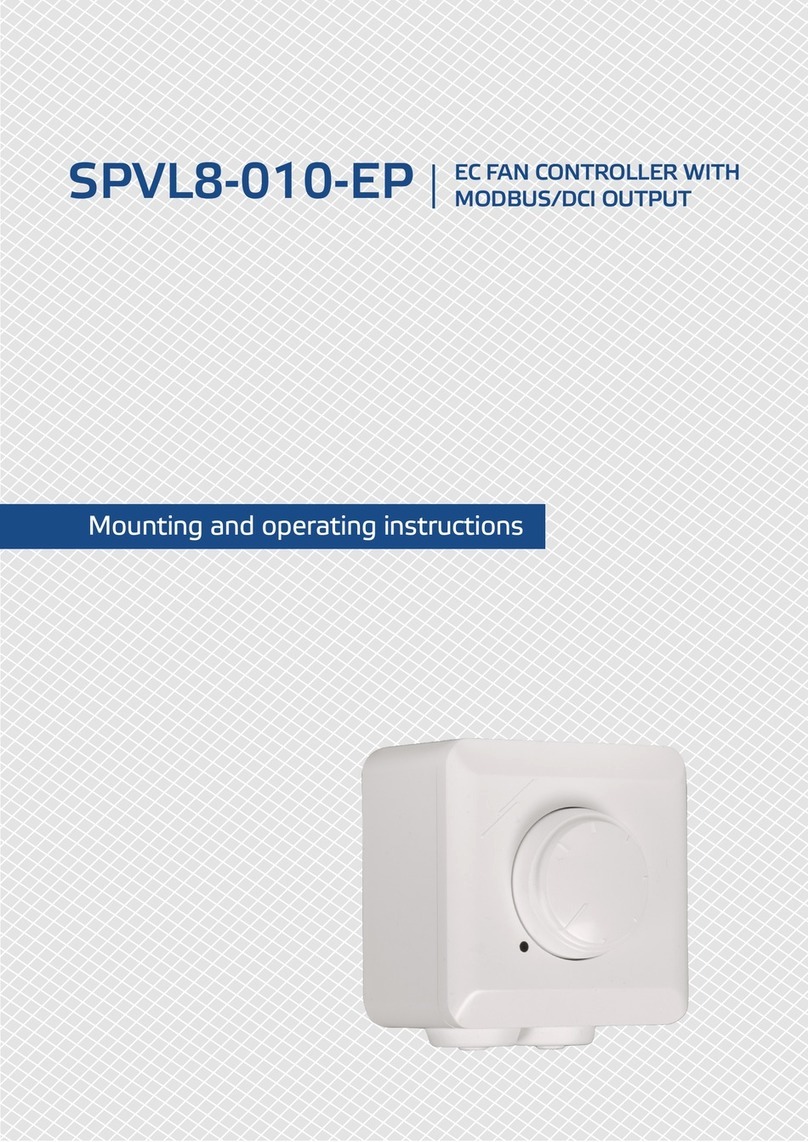
Sentera Controls
Sentera Controls SPVL8-010-EP Mounting and operating instructions
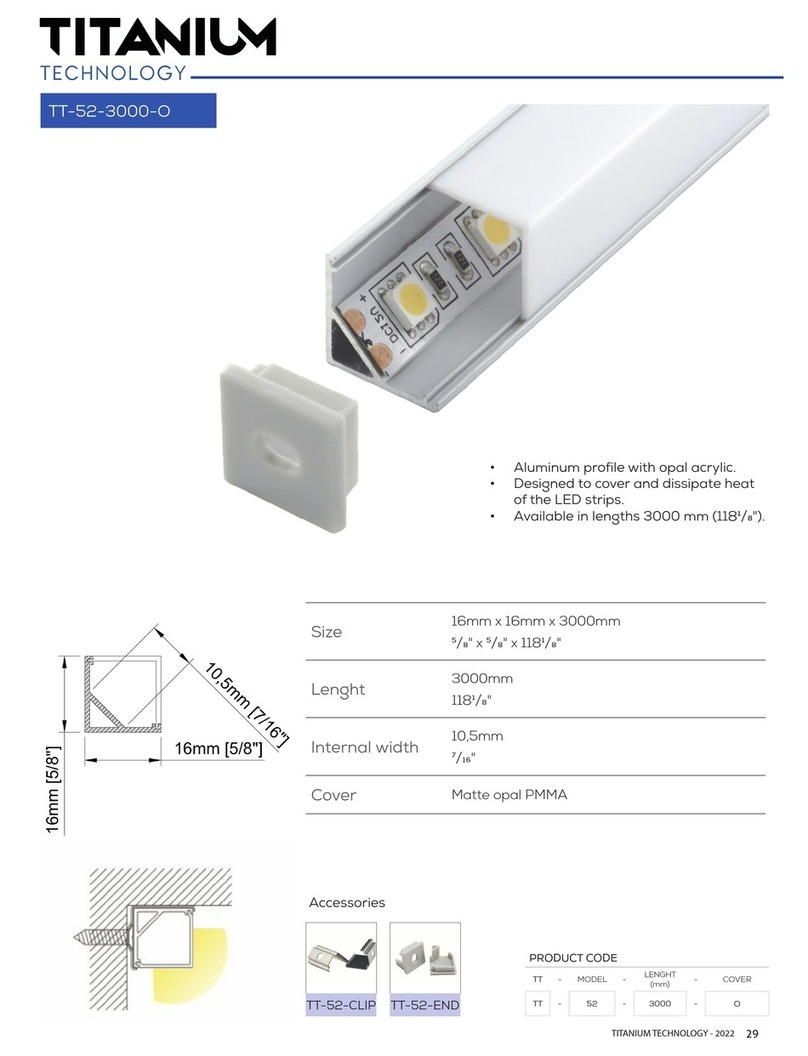
Titanium
Titanium TT-52-3000-O quick start guide
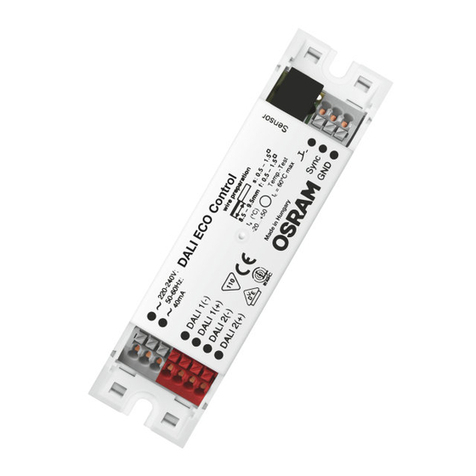
Osram
Osram DALIeco Installation and operation
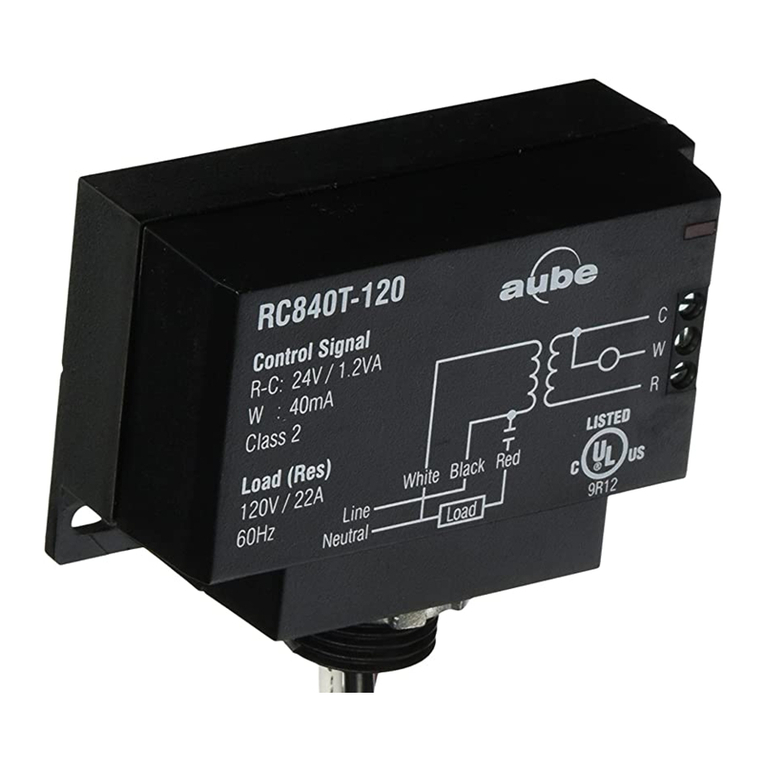
Aube Technologies
Aube Technologies RC840T installation guide
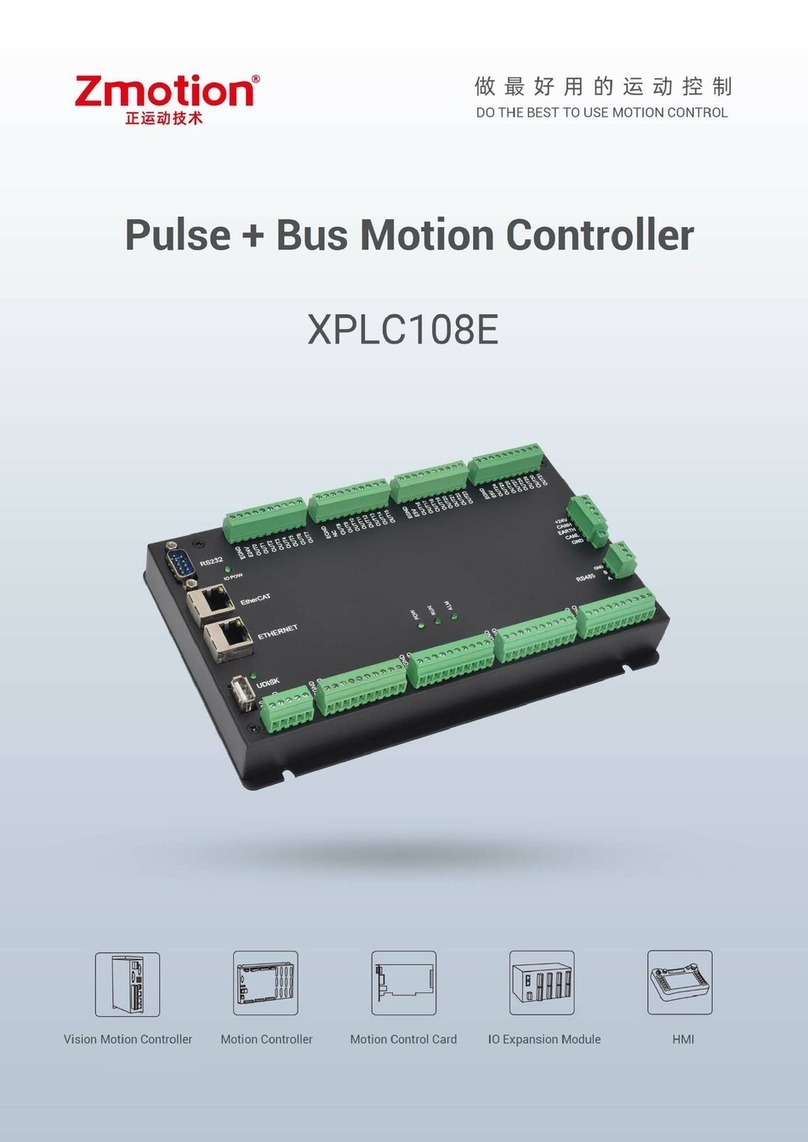
Zmotion
Zmotion XPLC108E manual
